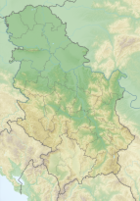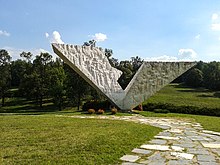Šumarice Memorial Park
| Šumarice Memorial Park | ||
|---|---|---|
 Aerial photo of a section of the park (2010) |
||
| Data | ||
| place |
Kragujevac , Šumadija , Serbia |
|
| architect | Smiljan Klaić, Mihajlo Mitrović , Radivoje Tomić | |
| Construction year | from 1955 | |
| Coordinates | 44 ° 1 '2.4 " N , 20 ° 53' 31.2" E | |
|
|
||
The Šumarice Memorial Park (also October Memorial Park ) is a memorial park in Kragujevac in Serbia that was created in 1955 . There are seven monuments in the park commemorating the Kraljevo and Kragujevac massacres . The park itself was designed by the landscape architect Smiljan Klaić with Mihajlo Mitrović and Radivoje Tomić . There is also the museum on October 21st , after the day of the Kragujevac massacre. The park, the museum and the monuments were created by important artists and architects of Yugoslavia and form an important testimony to the Yugoslav culture of remembrance.
park
The planning for the park was put out to tender in 1953. It was created from 1955 and consists of meadows and forest areas. The name Šumarice is derived from the Serbo-Croatian word šuma , which means forest .
Monuments
Pain and Disregard (1959)
44 ° 1 ′ 2 ″ N, 20 ° 53 ′ 31 ″ E
The Pain and Disregard memorial commemorates the only woman killed in the massacres, the student Nada Naumović . She was a supporter of the partisans and was declared a Yugoslav national heroine on December 20, 1951. It was the first memorial in the memorial park, was made of marble and depicts two stylized people, a half-hunched man and a woman, screaming with their heads back. It was designed by the Yugoslav sculptor Ante Gržetić .
On the monument there is an inscription engraved in the marble:
“On this mild hill, which she loved so much, the young student Nada Naumović, member of the Communist Party, fell together with 250 workers from Kragujevac. The Communist Party and the working class were on their minds. "
The sculpture was the subject of a GDR postage stamp in 1967 .
Broken wing (1961-63)
44 ° 0 '57.8 " N , 20 ° 53' 9.1" E
The Broken Wing Monument , also known as the memorial for the shot students and teachers , commemorates the students and teachers murdered in the massacre. It is depicted as a stylized wing on which desperate people are depicted. The competition for the monument was announced in 1961 and the monument was built from 1961 to 1963 according to plans by the Yugoslav sculptor Miodrag Živković . For the monument, Živković changed his rejected draft for the monument to the victory of the inhabitants of Slavonia . The monument made of concrete shows a broken wing and wants to remind in particular of the young age of the killed students, who were denied the opportunity to do something in their lives.
The memorial was erected directly on the site of the mass grave of the murdered students and teachers. It is the most famous monument in the park and has become a symbol for the entire city. The monument was also honored on a Yugoslav postage stamp.
Monument to Resistance and Freedom (1963)
44 ° 1 '31.8 " N , 20 ° 54' 0.7" E
The monument for resistance and freedom marks a mass grave from the massacre of October 1941, which is located at this point. It consists of a concrete obelisk about 12 meters high, the end of which forks, and a bronze statue. The obelisk has similarities to the Latin letter V, which could stand for Victory , i.e. the victory of the partisans over fascism.
The bronze statue shows a stylized person who is half collapsed from his wounds and lies on the ground. It symbolizes the people who were murdered here.
The monument and bronze were designed by the artist Ante Gržetić, who also created the pain and disregard monument (see above).
Crystal Flower (1968)
The Crystal Flower monument was created in 1968 by the Yugoslav artist Nebojša Delja . It commemorates a 15-year-old Roma who was shot at this point with various adults and buried in a mass grave.
The stylized budding flower is supposed to symbolize the purity and innocence of youth. It is cut in the middle to symbolize the premature end of this life.
On a stone near the monument is the Serbo-Croatian translation of the last line of the poem Kinderen met Krekelstem ( German Children with Cricket Voices ) by the Belgian-Flemish poet Karel Jonckheere :
"What I hear tonight, coming from the shiny grass, my lips cannot utter: Children with voices like crickets became crickets with voices like children"
Stone Sleeper (1970)
44 ° 1 ′ 38 "N, 20 ° 52 ′ 58" E
The Steinschläfer memorial commemorates the murdered people from the surrounding villages and towns, which are not mentioned in the other monuments. The monument consists of small terraced areas that are covered with concrete slabs and surrounded by small concrete pylons. There are also various abstract marble sculptures and a marble cylinder about two meters high. It was created in 1970 by the artist Gradimir Bosnić and the artist Jelica Bosnić .
On the cylinder there is a Serbo-Croatian inscription, the last line of the poem Brotnjice from the poetry book Steinschläfer (1966) by Mak Dizdar :
"Stone sleeper, I told you everything I knew about it, but if you want to know more, go and ask the birds"
Hundred for One (1980)
The Monument Hundred for One by the Yugoslav artist Nandor Glid from 1980 is made of bronze and placed on a concrete base. It shows human bodies arranged in the shape of a tree. This symbolizes both the beauty of the area in which this cruel act took place and the strength of the Serbian population to endure this suffering and to offer resistance.
The term one hundred for one refers to the instruction of the Wehrmacht officer Franz Böhme to murder one hundred Serbian civilians for every German soldier killed.
Circles (1981)
The Kreise monument was created in 1981 by the Yugoslav sculptor Vojin Bakić and is a reminder of the mass graves that are in its immediate vicinity. The monument consists of five connected stainless steel circles, all of which are deformed into the third room level. While circles stand for perfection and harmony, they symbolize the atrocities that were committed in this otherwise idyllic landscape.
Museum October 21
44 ° 1 '16.7 " N , 20 ° 53' 39.6" E
The on October 21, 1976 contains an exhibition, a library and various works of art related to the massacres. It was built from 1971 according to plans by the architects Ivana Antić and Ivanka Raspopović . The museum consists of 33 brick pillars that symbolize the 33 mass graves on the site. At the time of its opening, it was one of the most modern museums in Yugoslavia and used diverse audiovisual technology. Some of the museum's works of art are located both inside and in close proximity to the museum.
Development after the break-up of Yugoslavia
The park is still in good condition and is well maintained and visited. After the fall of Yugoslavia, a few more monuments were erected. Some monuments have been restored while others are in worse condition. However, the overall condition is good. The complex has been protected as a monument of outstanding importance since 1979 .








